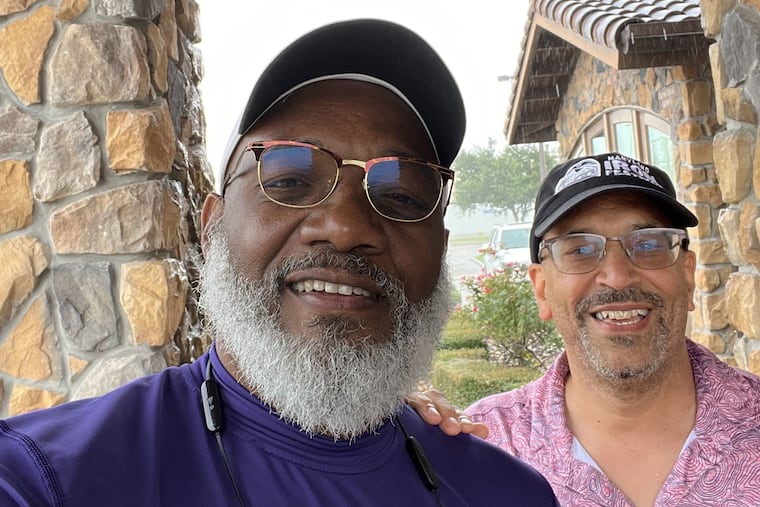Philadelphia ‘walking artist’ heads to Texas for 51-mile walk in the state where Juneteenth began
In Texas, Ken Johnston will meet longtime friend and Texas native Frank E. Thompson Jr., of Kansas City, Mo., who will join him on the walk from Galveston to Houston.

Philadelphia “walking artist” Ken Johnston flew to Texas on Tuesday to get a start on a 51-mile Juneteenth Emancipation Walk in the state where the holiday started.
On June 19, 1865, about 2,000 Union troops, under the command of Maj. Gen. Gordon Granger, arrived in Galveston to announce General Orders No. 3, a decree declaring freedom for enslaved Black people in Texas.
It was not true that news of the 1863 Emancipation Proclamation had traveled slowly to Texas, according to the Zinn Education Project: It was about people in power keeping knowledge from Black people that they should have been freed two years earlier by the Emancipation Proclamation on Jan. 1, 1863.
“When the order was read, over 250,000 Black people were freed across Texas,” Johnston said.
At the time, Houston was a small farming community and Galveston was the largest city in the state, with wealthy landowners, he said.
Johnston, 63, describes himself as a “walking artist,” who has made several long-distance walks marking civil rights, Underground Railroad, and abolition history. He founded Our Walk to Freedom to document his travels.
In Texas, Johnston will meet longtime friend and Texas native Frank E. Thompson Jr., of Kansas City, Mo., who will join him on the 51-mile walk from Galveston to Houston. The walk will end in Freedmen’s Town, a historic district in Houston where Black people, fleeing plantations in East Texas, started arriving in 1866 and built their own neighborhood.
Thompson, 57, grew up in Fort Worth celebrating Juneteenth, but never really learned the full story until he went to college.
“The history is not taught in schools,” said Thompson, the cofounder and CEO of a consulting firm in Kansas City.
For years, he did not realize that Juneteenth was unique to Texas, the last holdout among the Confederacy.
“That was upsetting, because up until high school, I actually thought Juneteenth was the end of slavery for the whole nation,” Thompson said.
The friends planned to make a short walk from Galveston to La Marque, Texas, on Tuesday evening. And on Juneteenth, they will start from La Marque to Houston, walking at least 12 miles a day, arriving there on Monday. To beat expected record-breaking Texas heat, Johnston said they will walk twice a day, early in the morning, from 5 to 9 a.m. and in the evening, from 7 to 8:30 p.m.
U.S. Colored Troops helped enforce emancipation
A little-known element that the Juneteenth National Observance Foundation uncovered was that there were 5,000 to 10,000 Black Union soldiers of the U.S. Colored Troops (USCT) who marched into Galveston at the same time as Granger.
“These actions provided a powerful image to the island’s enslaved people, who were oblivious to the fact that they had been granted freedom by Lincoln two years prior,” said the Juneteenth Legacy Project. The city of Galveston is located on Galveston Island, a barrier island on the Texas Gulf Coast. But there are small communities on the island that are not part of Galveston City.
» READ MORE: Philly ‘walking artist’ arrives in St. Catharines, Ontario, where Harriet Tubman once lived (from 2022)
Despite the wording of General Orders 3, which asked Black people to remain on the plantations and get paid for their work, many people fled to different Texas communities or left the state altogether.
“For me, this walk is a chance to reconnect with my Texas roots, including ancestors who were probably part of the original Juneteenth exodus,” Thompson said.
That exodus included some Black people who fled post-emancipation violence in Galveston and moved to Houston. Meanwhile, Johnston said the exodus went in two directions, with other Black residents leaving small towns to seek jobs in Galveston.
Emancipation Proclamation didn’t end slavery in all states
The Emancipation Proclamation did not free enslaved people in other states, besides Texas, Johnston noted.
When President Abraham Lincoln issued the Emancipation Proclamation in September 1862, it did not go into effect until Jan. 1, 1863. But the proclamation did not apply to enslaved Black people living in states that had not joined the Confederacy.
That means enslaved people in the border states of Delaware, Kentucky, Maryland, and Missouri were also kept enslaved in 1863.
Johnston believes what historian Sam Collins III told him: “True freedom didn’t really come until after the 13th Amendment was passed in December 1865.”
After emancipation, Texas passed laws requiring Black people to carry a pass to travel across the state, as many did, looking for work, Thompson said.
“If they didn’t have a pass, either law enforcement or white militia units would detain Black people, throw them in jail, and they would be subject to convict labor,” Thompson said. “There was a resistance to letting go of this free labor.”
The National Archives holds the original hand-written record of General Order No. 3, which states as follows:
The people of Texas are informed that, in accordance with a Proclamation from the Executive of the United States, all slaves are free. This involves an absolute equality of personal rights and rights of property between former masters and slaves, and the connection heretofore existing between them, becomes that between employer and hired labor. The Freedmen are advised to remain at their present homes, and work for wages. They are informed that they will not be allowed to collect at military posts; and that they will not be supported in idleness either there or elsewhere.